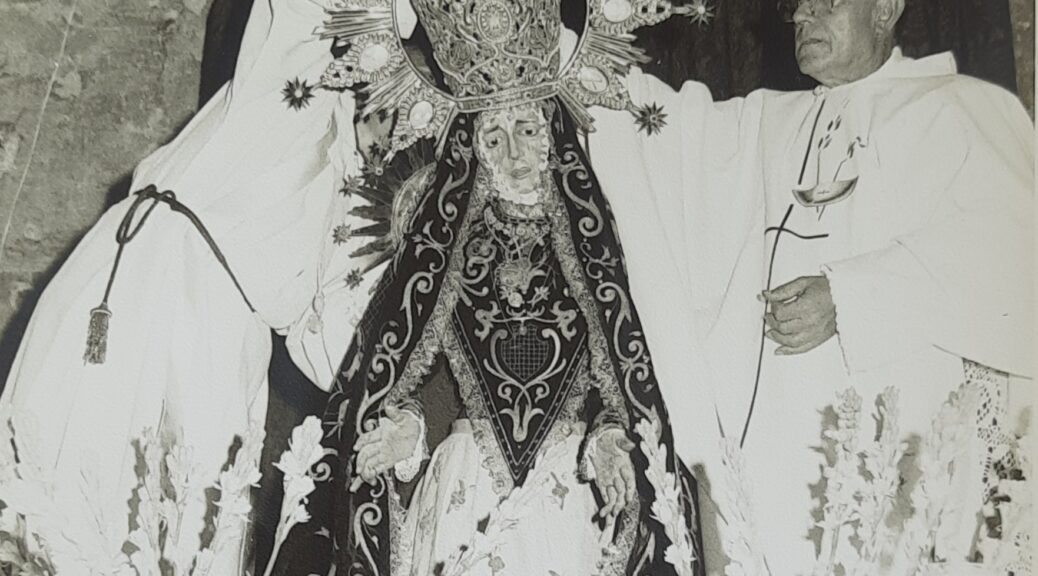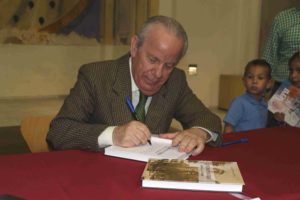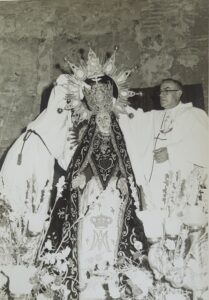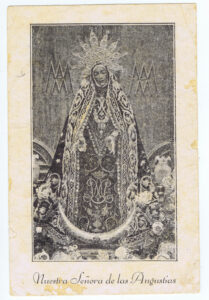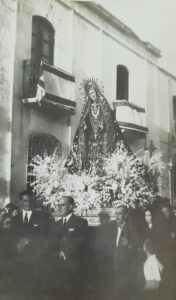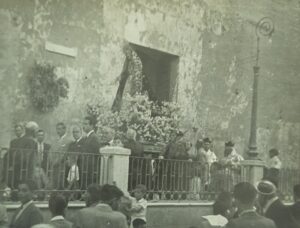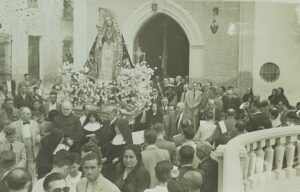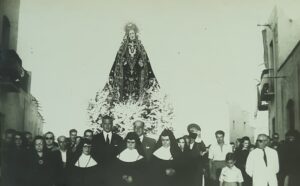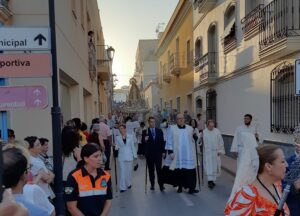Artículo de Gabriel Flores Garrido, cronista oficial de Vera, sobre la fiesta de la Patrona de Vera. Includes English version at the end. Includes English version at the end (elaborada por Francisco Javier Martínez Castro).
El 7 de junio de 1892, en sesión plenaria del Ayuntamiento presidido por su alcalde Diego Orozco Rosa, “se acordó celebrar el día diez del actual mes una función en honor de Nuestra Señora de las Angustias, Patrona de esta Ciudad, sacándola procesionalmente y que haya durante dos días iluminaciones”.
Durante 132 años se ha estado celebrando esta procesión, posiblemente siguiendo el mismo recorrido hasta ahora conocido. Ayer, viendo a la Virgen bajar el “Barrio de Jesús” (calle de San Ramón), quise reflejar esa imagen (que aquí publico) porque tuve la sensación de que, tanto esa como todas las que se hicieran en ese momento, y las tomadas en las calles del Sol y de la Plata, que se han añadido a este nuevo itinerario, formarían parte de la historia de la procesión de Nuestra Patrona: nunca hasta ayer había hecho este recorrido, y no sabemos si se volverá a repetir; en todo caso, el momento de ayer siempre será el primero.
La Virgen de las Angustias fue elegida como Patrona de Vera el 14 de febrero de 1891, fecha en la que se firmó en Roma el correspondiente certificado por la Sagrada Congregación de Ritos. El hecho lo comunica el alcalde Bartolomé Soler Clemente con estas palabras: “ha sido resuelto satisfactoriamente el expediente formado por este Ayuntamiento declarando a la Santísima Virgen de las Angustias como Patrona principal de esta Ciudad, juntamente con San Cleofás”.
En 1806 se vive una situación extraña por lo inusual del hecho. A causa del mal estado de su ermita, la Hermandad estableció un orden para que la Virgen fuera recibida en casas de los vecinos, evitando así que pudiera sufrir daños en caso de derrumbe de su capilla que, como quedó constancia en el acta de la junta de gobierno, celebrada ese año, se encontraba en estado ruinoso. Este “peregrinar” de la imagen daña la sensibilidad del secretario de la Hermandad, Antonio Narciso Navarro, que dice indignado no poder permitir que “la Efigie de Nuestra Señora y las, demás de la Cofradía anden rodando indecentemente por las casas particulares donde tienen la bondad de recogerlas”. Sin duda el secretario exageraba porque nadie puede creer que una imagen tan venerada por los veratenses no fuera custodiada con el mayor decoro, respeto y devoción. Posiblemente, su intención fuera espolear a los vecinos para que se esforzaran en la reconstrucción del templo. Malos tiempos para pedir sacrificios económicos.
La Virgen siempre estuvo iluminada como lo prueba el elevado gasto en aceite y cera para, como dice una partida del libro de cuentas de 1799, “alumbrar constantemente a la soberana imagen de la Virgen en la capilla”, gasto que se repite anualmente. Justo un siglo más tarde, en 1905, el hermano mayor de la Hermandad, Francisco Montoro Reyes, colabora económicamente para que fuera posible la instalación de la luz eléctrica en su ermita, y Francisco Enciso Prieto, administrador de la compañía de electricidad en Vera, se ofrece para pagar los materiales necesarios y el consumo de la luz que iluminaría el Viernes Santo a un Crucificado que se encontraba en la capilla de la Virgen, y del que nada se sabe ni ha llegado hasta nosotros.
En octubre de 1973 la Virgen de las Angustias fue coronada por el párroco D. Juan Fernández Marín en un solemne acto de coronación celebrado en la plaza Mayor. Recuperaba así su corona, aunque fuera una réplica de la original, desaparecida décadas antes.
Comenzaba a remediarse la penuria que tradicionalmente han padecido Hermandades y Cofradías, al menos en nuestra ciudad.
Gabriel Flores Garrido. (11 de junio de 2024)
Las fotografías publicadas son propiedad de Francisca de los Ángeles Caparrós Cervantes (distintos planos de la procesión de la Patrona tomados entre las décadas de 1940 y 1950), de María Alonso Caparrós (coronación) y de Antonia Ramírez Gerez (imagen de la Virgen de aproximadamente en 1950 e instantánea tomada ayer en el barrio de Jesús).
Traducción de Francisco Javier Martínez
10 DE JUNIO: DÍA GRANDE EN VERA
JUNE 10: BIG DAY IN VERA Article by Gabriel Flores Garrido, official chronicler of Vera, about the festival of the Patroness of Vera. On June 7, 1892, in a plenary session of the City Council chaired by its mayor Diego Orozco Rosa, "it was agreed to celebrate on the tenth of the current month a function in honor of Our Lady of Sorrows, Patroness of this City, carrying her out in a procession and there will be illuminations for two days.” This procession has been celebrated for 132 years, possibly following the same route known until now. Yesterday, watching the Virgin go down the “Barrio de Jesús” (San Ramón Street), I wanted to reflect that image (which I publish here) because I had the feeling that, both that one and all the others that were made at that time, and the Taken in the streets of Sol and La Plata, which have been added to this new itinerary, they would form part of the history of the procession of Our Patroness: never until yesterday had she done this route, and we do not know if it will be repeated again; In any case, yesterday's moment will always be the first. The Virgin of Sorrows was chosen as Patroness of Vera on February 14, 1891, the date on which the corresponding certificate was signed in Rome by the Sacred Congregation of Rites. The fact is communicated by Mayor Bartolomé Soler Clemente with these words: “the file formed by this City Council declaring the Blessed Virgin of Sorrows as the main Patroness of this City, together with San Cleofás, has been satisfactorily resolved.” In 1806 a strange situation occurred due to the unusual nature of the event. Due to the poor condition of its hermitage, the Brotherhood established an order for the Virgin to be received in the neighbors' houses, thus preventing it from suffering damage in the event of the collapse of its chapel, which, as was recorded in the record of the meeting of government, done that year, was in a ruinous state. This “pilgrimage” of the image damages the sensitivity of the secretary of the Brotherhood, Antonio Narciso Navarro, who says indignantly that he cannot allow “the Effigy of Our Lady and the rest of the Brotherhood to roll indecently through the private houses where they have the goodness of collecting them.” Without a doubt the secretary was exaggerating because no one can believe that an image so revered by the people of Vera was not guarded with the greatest decorum, respect and devotion. Possibly, his intention was to encourage the neighbors to make efforts to rebuild the temple. Bad times to ask for economic sacrifices. The Virgin was always illuminated as proven by the high expenditure on oil and wax to, as an entry in the 1799 account book says, “to constantly illuminate the sovereign image of the Virgin in the chapel”, an expense that is repeated annually. Just a century later, in 1905, the higher brother of the Brotherhood, Francisco Montoro Reyes, collaborated financially to make it possible to install electric lights in her hermitage, and Francisco Enciso Prieto, administrator of the electricity company in Vera, he is offered to pay for the necessary materials and the consumption of the electricity that would illuminate on Holy Friday a Crucified figure who was in the chapel of the Virgin, and about whom nothing is known or has reached us. In October 1973 the Virgin of Angustias was crowned by the parish priest D. Juan Fernández Marín in a solemn coronation ceremony held in the Plaza Mayor. Thus he recovered her crown, although it was a replica of the original, which had disappeared decades before. The shortage that Brotherhoods and Brotherhoods have traditionally suffered was beginning to be remedied, at least in our city. Gabriel Flores Garrido. (June 11, 2024) The published photographs are the property of Francisca de los Ángeles Caparrós Cervantes (different plans of the procession of the Patroness taken between the 1940s and 1950s), María Alonso Caparrós (coronation) and Antonia Ramírez Gerez (image of the Virgin of approximately in 1950 and snapshot taken yesterday in the Jesús neighborhood).
